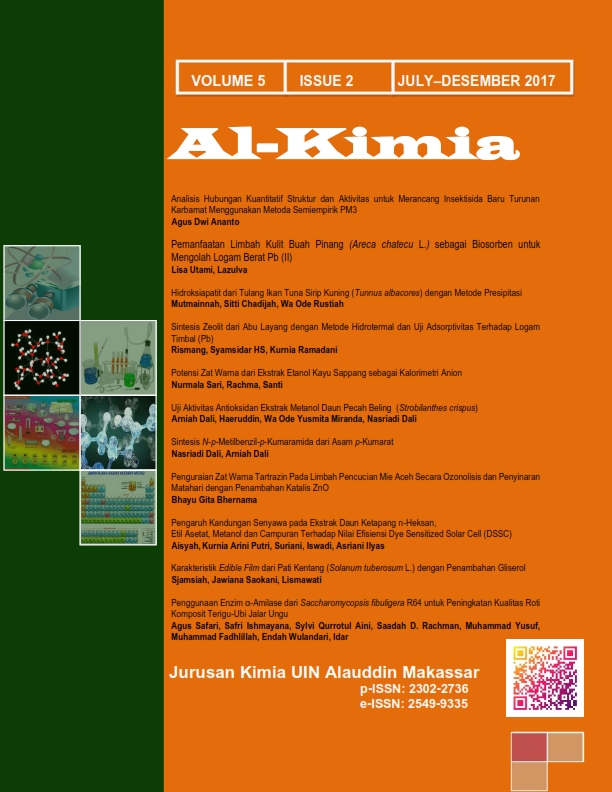Penggunaan Enzim α-Amilase dari Saccharomycopsis fibuligera R64 untuk Peningkatan Kualitas Roti Komposit Terigu-Ubi Jalar Ungu
Abstract
Purple sweet potato (Ipomoea batatas var. Ayamurasaki) is one of typical sweet tubers which is also commonly well known as Ipomoea blackie due to blackish purple (solid purple) tuber skin and flesh. The sweet potato can be transformed into flour or pasta and used to substitute wheat flour in the production of composite bread. Instead of synthetic chemical compounds, α-amylase isolated from the yeast Saccharomycopsis fibuligera can be added to the flour or dough of the composite bread to improve its quality. The purpose of the present study was to investigate the effect of α–amylase addition on the quality of the purple sweet potato flour and pasta composite bread. The observed properties of the bread were crumbs morphology of the bread, volume increment, bread height, texture, and organoleptic test. The results showed that addition of the α-amylase to the dough of the composite bread increased the volume increment value from 155.0% to 177.1% and from 335.7% to 342.1% for the sweet potato flour and pasta bread composite, respectively. While height of the bread increased from 4.7 to 5.1 cm and from 6.9 to 7.8 cm after addition of the enzyme for the sweet potato flour and pasta bread composite, respectively. Composite bread with α-amylase addition has softer texture and higher preference. Morphology examination result showed that starch granules in the bread crums with α-amylase treatment were disrupted. Most plausibly, the enzymes degrade the starch granules and produced dextrin which inhibited the cross linking formation between starch and protein, and therefore, the speed of hardening process of the bread can be reduced.
Downloads
References
Allen, J.C. , Corbitt, A.D., Maloney, K. P., Butt, M. S. & Truong, V.D. (2012). Glycemic index of sweet potato as affected by cooking methods, The Open Nutrition Journal, 6, 1-11.
Arlene, A., Witono, J.T. & Fransisca, M. (2009). Pembuatan roti tawar dari tepung singkong dan tepung kedelai. Simposium Nasional RAPI VIII 2009, K80-K84.
Fuwa, H. (1954). A new method for microdetermination of amylase activity by the use of amylose as the substrate, Journal of Biochemistry, 41, 83-603.
Hardoko, L. Hendarto & Siregar, T.M. (2010). Pemanfaatan ubi jalar ungu (Ipomoea batatas L. Poir) sebagai pengganti sebagian tepung terigu dan sumber antioksidan pada roti tawar. Jurnal Teknol dan Industri Pangan, 21, 25-32.
Ismaya, W.T., Hasan, K., Kardi, I., Zainuri, A., Rahmawaty, R.I., Permanahadi, S. , El Viera, B.Q., Harinanto, G., Gaffar, S.,...Natalia, D. (2013). Chemical modification of saccharomycopsis fibuligera r64 α-amylase to improve its stability against thermal, chelator, and proteolytic inactivation, Applied Biochemistry and Biotechnology, 170, 44-57.
Krisnawati, R. & Indrawati, V. (2014). Pengaruh substitusi purre ubi jalar ungu (ipomea batatas) terhadap mutu organoleptik roti tawar, e–Journal Boga, 3, 79-88.
Mushtafa, M.Z. (2011). Pengaruh imbangan tepung terigu dan pasta ubi jalar ungu (Ipomea batatas Kultivar Ayamurasaki) terhadap karakteristik roti tawar, Skripsi, Universitas Padjadjaran Bandung.
Richana, N. (2012). Ubi Kayu dan Ubi Jalar. Bandung: Nuansa Cendikia.
Richana, N., Budiyanto, A. & Mulyawati, I. (2010). Pembuatan tepung jagung termodifikasi dan pemanfaatannya untuk roti. Prosiding Pekan Serealia Nasional, 446-454.
Richana, N. & Widaningrum,. (2009). Penggunaan tepung dan pasta dari beberapa varietas ubi jalar sebagai bahan baku mi, Jurnal Pascapanen, 6, 43-53.
Safari, A., Kamara, D..S., Silalahi, F., Fadhlillah, M., Kardi, I. & Ishmayana, S., (2013). Partial hydrolysis of purple sweet potato flour by amylase from saccharomycopsis fibuligera and its application for composite breadmaking, Journal of Microbiology, Biotechnology and Food Sciences, 2, 2340-2343.
Suda, I., Oki, T., Masuda, M., Kobayashi, M., Nishiba, Y & Furuta, S. (2003). Physiological functionality of purple-fleshed sweet potatoes containing anthocyanins and their utilization in foods, Japan Agricultural Research Quarterly: JARQ, 37, 167-173.
Syamsir, E. (2011). Bread Staling, Kulinologi Indonesia, 3, 20-23.
Willcox, D.C., Willcox, J. B., Todoriki, H. & Suzuki, M. (2009). The okinawan diet: health implications of a low-calorie, nutrient-dense, antioxidant-rich dietary pattern low in glycemic load, Journal of the American College of Nutrition, 28, 500S–516S.
Copyright (c) 2017 Agus Safari, Safri Ishmayana

This work is licensed under a Creative Commons Attribution-NonCommercial-ShareAlike 4.0 International License.
Authors who publish with this journal agree to the following terms:
1) Authors retain copyright and grant the journal right of first publication with the work simultaneously licensed under a Creative Commons Attribution License that allows others to share the work with an acknowledgement of the work's authorship and initial publication in this journal.
2) Authors are able to enter into separate, additional contractual arrangements for the non-exclusive distribution of the journal's published version of the work (e.g., post it to an institutional repository or publish it in a book), with an acknowledgement of its initial publication in this journal.
3)Authors are permitted and encouraged to post their work online (e.g., in institutional repositories or on their website) prior to and during the submission process, as it can lead to productive exchanges, as well as earlier and greater citation of published work (See The Effect of Open Access).


